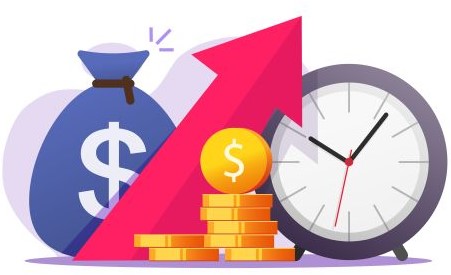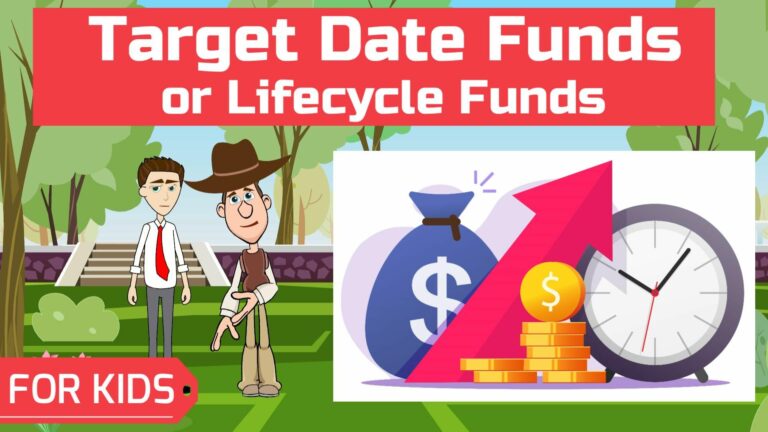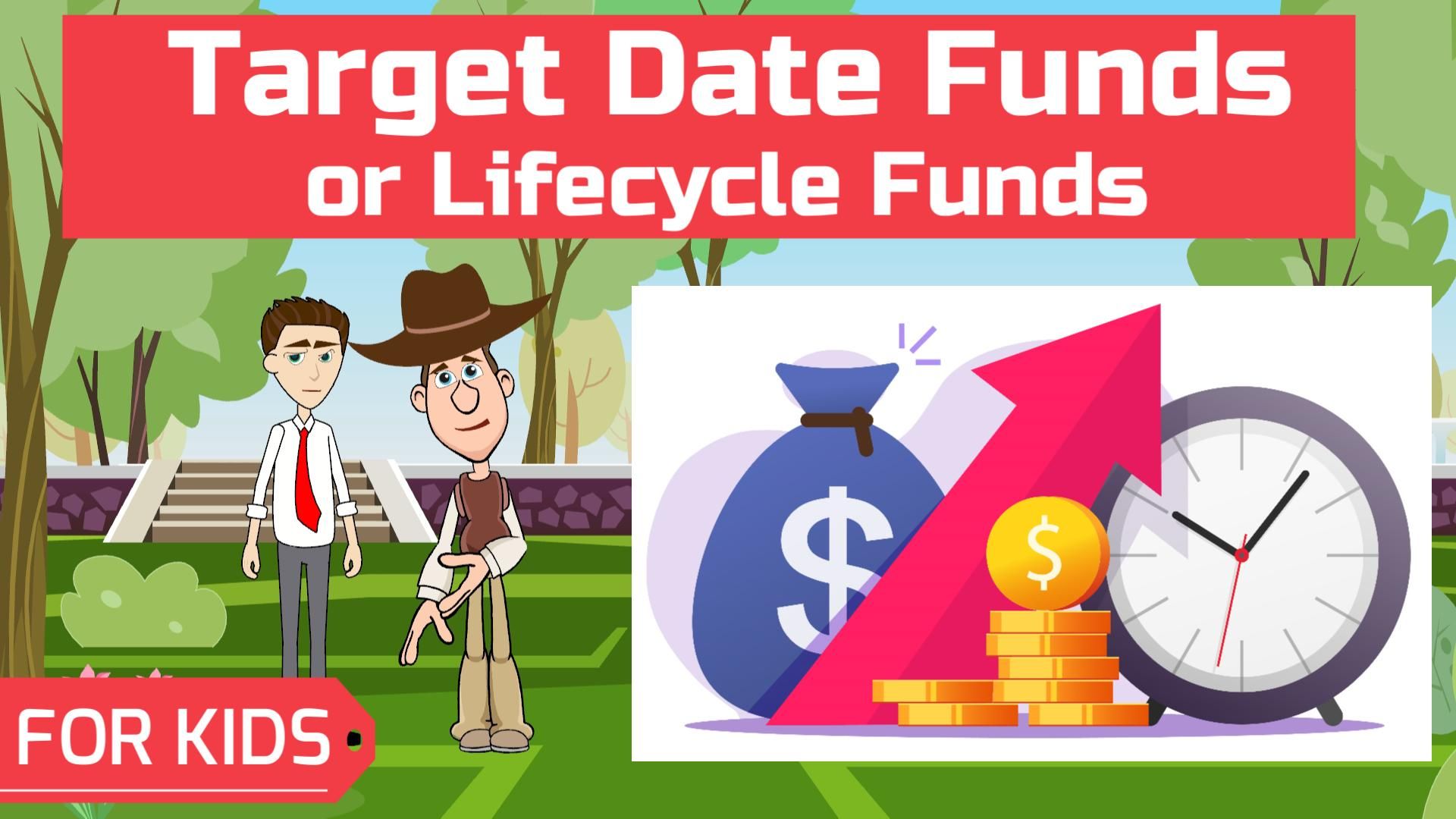Part 1: What is a Target Date Fund (TDF), How Does it Work, What Happens After the Target Date
Part 2: Pros and Cons of a Target Date Fund (TDF), Should You Invest in a TDF, How to Invest in a Lifecycle Fund
Introduction to Target Date Funds for Kids and Teens
This video explains the concept of a Target Date Fund in a simple, concise way for kids and beginners. It could be used by kids & teens to learn about a lifecycle fund, or used as a money & personal finance resource by parents and teachers as part of a Financial Literacy course or K-12 curriculum.

Suitable for students from grade levels:
- Kindergarten
- Elementary School
- Middle School
- High School
The topics covered are:
- What is a Target Date Fund (TDF)
- How do TDFs manage risk and achieve optimal asset allocation
- What happens after the target date – can I continue to invest
- What are the advantages of Target Date Funds
- Are there any disadvantages of TDFs
- Should You Invest in a Lifecycle Fund
- How can You invest in a Lifecycle Fund
What is a Target Date Fund (TDF)?
A target date fund (or TDF), also known as Lifecycle Fund, is a type of mutual fund or Exchange Traded Fund (ETF) that manages investments by looking at a specific time horizon.

The end of this horizon is the fund’s target date, which is also indicated in the fund’s name – for example, 2040 Retirement Fund.
TDFs are usually issued with maturity in 5 year intervals (for example, 2030, 2035, 2040 etc.), so investors can choose the ones closest to the time they would need the money to meet a financial goal.
Lifecycle funds usually start out with a higher percentage of equities, but over time, they become more conservative and shift their allocation to a higher percentage of fixed income. They are usually rebalanced every year in order to readjust risk and optimize asset allocation based on the time remaining until the target date.
Target date funds are also called Fund of Funds, as most of them invest in other mutual funds or ETFs (exchange-traded funds) instead of individual securities.
How do TDFs manage risk and achieve optimal asset allocation?
TDFs are usually used for long term goals like college tuition and retirement. So all TDFs follow a glide path, which indicates how their investments shift between equities and fixed income over the life of the TDF.
Let’s look at an example with a TDF that has a target date of 2050. At the beginning, the fund would invest 80% in stocks and 20% in bonds. However, as it approaches the target date, it will become more conservative: in 2030 it would have 70% in stocks and 30% in bonds, in 2040 it would be 50-50, and in 2050 it would be 30-70.
Early on, when the target date is far away, the investors can handle more risk and therefore the TDF has an aggressive asset allocation for potentially higher returns. Even if there are any losses along the way, the fund has time to recover.
But as the target date approaches, the risk tolerance goes down and therefore the TDF has a more conservative asset allocation.
What happens after the target date? Can I continue the Lifecycle Fund even after the target date?
Yes, but what happens to your investment depends on the type of TDF.
A type of TDF called “to-fund” freezes at the target asset allocation and continues the same proportion indefinitely.
A “through-fund” continues rebalancing the portfolio and adjusting the asset allocations making it more and more conservative as time passes.
What are the advantages of Target Date Funds?
The biggest benefit of Target Date funds is their ‘set it and forget it’ approach. They’re easy for anyone to invest in, without having any knowledge or expertise.

The investor doesn’t have to worry about picking good investments, the right asset allocation, rebalancing their portfolio or achieving diversification – the fund takes care of everything. All the investors need to know is the time frame for their goal. Because of this, lifecycle funds are a popular option in 401k plans.
Also, because TDFs optimize the asset allocation based on the target date, investors don’t need to invest in anything other than a Lifecycle Fund.
Another advantage of this autopilot way of investing is that it takes the emotion out of investing and prevents investors from adversely reacting to market ups and downs.
Are there any disadvantages of TDFs?
One important disadvantage of Target Date Funds is that they are not very flexible. They follow a predetermined glide path, and if you decide to retire earlier or later than the fund’s target date, the asset allocation may not remain optimal for you.
Like with any other investment, they are subject to risk and under performance – so there are no guaranteed returns. And even if they generate gains, they may not be enough to keep up with inflation over the time horizon.
Also, since lifecycle funds are typically fund of funds, they can have high fees, which include their own fees and that of the funds they invest in.
Should I invest in a TDF? Is Target Date Fund a good idea for me?
TDFs assume a one-size-fits-all approach, and the investments they make may not be the best for you specifically.

So if you are a responsible investor who is able to invest consistently, it’s probably best to avoid lifecycle funds. But if you aren’t a very savvy investor or don’t have the time to keep up with your investments, a Target Date Fund could be right for you.
If you decide to invest in a target date mutual fund, an important thing to remember is that while there could be multiple TDFs for the same target date, they won’t invest in the same assets or in the same proportion.
Some might focus on domestic stocks, while others could be a mix of domestic and international stocks. Some may have a glide path that’s too conservative, while others may not be conservative enough!
There is no best target date fund: just make sure the TDF’s investment strategy aligns with yours.
How can I invest in a Lifecycle Fund?
You can do that through your employer’s 401k, if they offer TDFs. You can also invest in TDFs through an IRA. Both these options are tax-advantaged.
Another non-tax advantaged option is to buy TDFs from an online broker or directly from fund companies that offer them.
Download Transcript: Ideal for Use by Teachers in their Lesson Plan to Teach Kids & Teens
Part 1: What is a Target Date Fund (TDF), How Does it Work, What Happens After the Target Date
Part 2: Pros and Cons of a Target Date Fund (TDF), Should You Invest in a TDF, How to Invest in a Lifecycle Fund
Podcast: What is a Target Date Fund (TDF) or Lifecycle Fund
Part 1: What is a Target Date Fund (TDF), How Does it Work, What Happens After the Target Date
Fun, informative and concise episodes by a 10-year old, breaking down complex financial concepts in a way that kids and beginners can understand. Episodes cover personal finance topics like saving, investing, banking, credit cards, insurance, real estate, mortgage, retirement planning, 401k, stocks, bonds, income tax, and more, and are in the form of a conversation between a cowboy (a finance novice) and his friend, a stock broker. Making finance your friend, only at Easy Peasy Finance.
A little bit about me: I have been fascinated with the world of personal finance since I was 6! I love to read personal finance books, and keep myself updated on the latest by reading various personal finance magazines. My friends often ask me questions about finance because they find it complex and intimidating. That’s what inspired me to start my YouTube channel called Easy Peasy Finance when I was 8, and this podcast 2 years later.
Everything you need to know about Target Date Funds / TDF / Lifecycle Funds: What is a Target Date Fund, how do TDFs manage risk and achieve optimal asset allocation, what happens after the target date – can I continue to invest, what are the advantages of Target Date Funds, are there any disadvantages of …

Part 2: Pros and Cons of a Target Date Fund (TDF), Should You Invest in a TDF, How to Invest in a Lifecycle Fund
Fun, informative and concise episodes by a 10-year old, breaking down complex financial concepts in a way that kids and beginners can understand. Episodes cover personal finance topics like saving, investing, banking, credit cards, insurance, real estate, mortgage, retirement planning, 401k, stocks, bonds, income tax, and more, and are in the form of a conversation between a cowboy (a finance novice) and his friend, a stock broker. Making finance your friend, only at Easy Peasy Finance.
A little bit about me: I have been fascinated with the world of personal finance since I was 6! I love to read personal finance books, and keep myself updated on the latest by reading various personal finance magazines. My friends often ask me questions about finance because they find it complex and intimidating. That’s what inspired me to start my YouTube channel called Easy Peasy Finance when I was 8, and this podcast 2 years later.
Should you be investing in target date funds or lifecycle funds? Here’s a guide: What are the advantages of Target Date Funds, are there any disadvantages of TDFs, should you invest in a lifecycle fund, how can you invest in a lifecycle fund, and more. Show notes and transcript at What is a Target Date …


